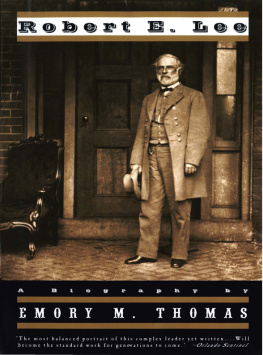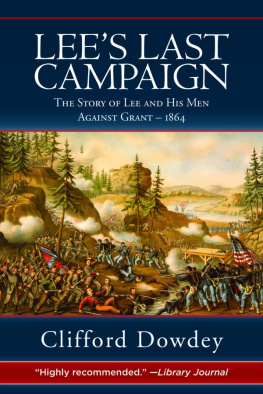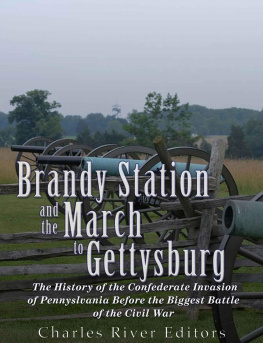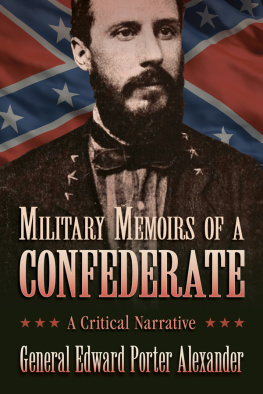PREFACE
THE nine men who are the subject of this book will not be unfamiliar to Civil War enthusiasts but, to the average American, they are little remembered if not, indeed, forgotten. Yet each in his way played a dramatic role in the Confederate service.
Three of these ConfederatesTurner Ashby, Pat Cleburne, and Billy Mahonehave had books written about them, but none has been widely circulated.
Two others, Dick Taylor and E. Porter Alexander, wrote about the war in which they served so brilliantly. But whereas many know Taylors Destruction and Reconstruction and Alexanders Military Memoirs of a Confederate , how many know these two remarkable soldiers themselves, or their exploits throughout four years of bitter fighting?
Parts of the astonishing saga of Charles W. Savez Read of the Confederate Navy have been told in various places, but the entire career of this fantastic young Mississippian has never before been extensively treated.
The same is true of the careers of the much-despised Lucius B. Northrop, Commissary General of the Confederacy, and the much-loved Willie Pegram, a dazzling cannoneer.
The remaining member of the Nine Men in Gray did not, after the first three months of the war, wear a Confederate uniform for he was sent to England as the Confederate propaganda agent. In that capacity, young Henry Hotze distinguished himself to such a degree as to emerge as one of the ablest of all persons in the Confederate service.
Six of the nine came into the Confederacy from civilian lifeTaylor, Ashby, Cleburne, Pegram, Mahone, and Hotze. Northrop and Alexander, West Point graduates, resigned from the United States Army, while Read, a graduate of Annapolis, resigned from the United States Navy, to cast their lot with the South. Six of the nine survived the war, Ashby, Cleburne, and Pegram being killed in action.
In the sketches of those who lived through the war, a brief summary of their postwar careers has been given; in all pieces the pre-war lives have been outlined. But the emphasis throughout has been on their Confederate careers.
The author is under great obligations to many persons and institutions for assistance during the researching of this book. Robert Talmadge, librarian of Tulane University and his staff, specifically, Mrs. Connie Griffith, Miss Betty Mailhes, Mrs. Dorothy Whittemore, Mrs. Patricia Segleau, and Bill Naez, have put the author deeply in their debt by their cheerful cooperation and innumerable services.
So, too, have Mrs. Carolyn A. Wallace of the Southern Historical Collection, University of North Carolina; Miss Mattie Russell, Curator of Manuscripts, Duke University, and her assistant, Mrs. Virginia Gray; and Howson W. Cole, Curator of Manuscripts, Virginia Historical Society, Richmond, and his staff.
Ray D. Smith of Chicago, who has undertaken the monumental task of indexing The Confederate Veteran , graciously furnished the author with many references to each of the nine Confederates in that publication.
Valuable help is acknowledged from the following:
Vergil Bedsole, director of the Department of Archives and Manuscripts, Louisiana State University, and his staff; Arthur Ben Chitty, University of the South, Sewanee, Tennessee; Don Dosch, National Park Service historian at Shiloh, Tennessee; Gilbert E. Govan of Chattanooga; Tom Harrison, National Park Service historian at Petersburg, Virginia; Congressman F. Edward Hbert of Louisiana; Robert W. Hill, Curator of Manuscripts, New York Public Library; Stanley F. Horn of Nashville; William Kay, National Park Service historian at Richmond, Virginia; Dr. Grady McWhinney of Northwestern University; E. B. Pete Long, Oak Park, Illinois; Mallory J. Read of Arlington, Virginia; John R. Peacock, High Point, North Carolina; Ray Samuel of New Orleans; Frank B. Sarles, Jr. of Omaha, Nebraska; Miss India Thomas, regent, the Confederate Museum, Richmond, and her assistant, Miss Eleanor Brockenbrough; Mrs. E. M. Trigg of Savannah, Georgia; Lee Wallace, National Park historian, Washington, D.C.; and Dr. T. Harry Williams of Louisiana.
As always, the Library of Congress Manuscripts Division and the National Archives provided matchless service. The usual fine cooperation came from the New Orleans Public Library, Jerome Cushman, librarian.
Kenneth T. Urquhart, director of Memorial Hall of the Louisiana Historical Association, New Orleans, was generous in the loan of valuable source material.
To my colleagues on the New Orleans States-Item , Hermann B. Deutsch, Crozet Duplantier, and Dan Galouye, go thanks for reading the galley proofs. Previously, Mr. Galouye read the manuscript and made valuable suggestions.
Also lending a vigilant eye to the proofs were Mrs. Tess Crager, Leonard V. Huber, Ren LeGardeur, Jr., and Donald Schultz, all of New Orleans.
Edison B. Allen of Tulane University, a keen student of the Civil War, accompanied the author on field trips to many of the battlefields, and he read the manuscript, detecting errors and making valuable suggestions. He also read the proofs.
To Ezra Warner of La Jolla, California, the author is indebted for the loan of pictures from his valuable Civil War collection. A similar debt is acknowledged to Miss Regina Rapier of Atlanta, Georgia, who supplied a photograph of Henry Hotz.
Special thanks are due Polly LeBeuf for her patience in typing the manuscript and also for reading proofs.
For whatever errors remain after the careful assistance of these gracious friends, the author assumes full responsibility.
CHARLES L. DUFOUR









